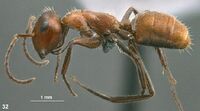Camponotus weiserti
| Camponotus weiserti | |
|---|---|

| |
| Scientific classification | |
| Kingdom: | Animalia |
| Phylum: | Arthropoda |
| Class: | Insecta |
| Order: | Hymenoptera |
| Family: | Formicidae |
| Subfamily: | Formicinae |
| Tribe: | Camponotini |
| Genus: | Camponotus |
| Subgenus: | Myrmamblys |
| Species group: | inquilinus |
| Species: | C. weiserti |
| Binomial name | |
| Camponotus weiserti Zettel & Laciny, 2018 | |
Only known from the type locality in Phang-nga Province, Thailand.
Identification
Zettel et al. (2018) - Minor worker: Body chiefly light reddishbrown; head somewhat darker; gaster ventrally infuscated. Pronotum with long standing setae. Trunk with dense microreticulation, matt; only pronotum with weaker sculpture, shiny. Clypeus basally shallowly emarginated. Flagellum of normal length, antennomere 7 about twice as long as wide. Dorsal outline of entire mesosoma slightly convex, of pronotum moderately convex, in front of propodeum with shallow depression.
Major worker unknown.
This species is similar to Camponotus sophiae from the same locality. It differs by a shinier, less reticulated pronotum, a normally long antennal flagellum, a concave dorsal outline between mesonotum and propodeum, and slightly shorter and less abundant standing setae. It differs from Camponotus concurrens by the only moderately convex pronotum (humped in minors of C. concurrens) and bearing long standing setae, and by the shallow depression in the anterior part of the propodeum.
Keys including this Species
Distribution
Distribution based on Regional Taxon Lists
Oriental Region: Thailand (type locality).
Distribution based on AntMaps
Distribution based on AntWeb specimens
Check data from AntWeb
Countries Occupied
| Number of countries occupied by this species based on AntWiki Regional Taxon Lists. In general, fewer countries occupied indicates a narrower range, while more countries indicates a more widespread species. |

|
Estimated Abundance
| Relative abundance based on number of AntMaps records per species (this species within the purple bar). Fewer records (to the left) indicates a less abundant/encountered species while more records (to the right) indicates more abundant/encountered species. |

|
Biology
Castes
Nomenclature
The following information is derived from Barry Bolton's Online Catalogue of the Ants of the World.
- weiserti. Camponotus (Myrmamblys) weiserti Zettel & Laciny, in Zettel, Balàka, et al. 2018: 144, figs. 32-35 (w.) THAILAND.
- Type-material: holotype minor worker, 3 paratype minor workers.
- Type-locality: holotype Thailand: Phang-nga Prov., Khao Lak NP, Thone Chong Fa Falls, 8°40’N, 98°18’E, 100-300 m., (no collection date), T11 (A. Schulz & K. Vock); paratypes with same data.
- Type-depository: NHMW.
- Status as species: Khachonpisitsak, et al. 2020: 47.
- Distribution: Thailand.
Unless otherwise noted the text for the remainder of this section is reported from the publication that includes the original description.
Description
Worker
Minor
Holotype: HW 1.22; HL 1.41; SL 1.28; SW 0.15; EL 0.38; ML 1.89; HaL 0.27; FeL 1.60; CI 86; SI 105; EI 31; FeI 131. Ward’s Indices: ASM/HWex 0.29; ASM/CLW 0.59; CLW/CLL 1.47. Paratypes (n = 3): HW 1.24–1.28; HL 1.37–1.43; SL 1.26–1.28; SW 0.14–0.15; EL 0.38–0.39; ML 1.83–1.92; HaL 0.20–0.25; FeL 1.57–1.70; CI 86–94; SI 100–102; EI 31; FeI 122–137. Ward’s Indices: ASM/HWex 0.27–0.28; ASM/CLW 0.55–0.57; CLW/CLL 1.40–1.56.
Structures: Head roundish, uniformly reticulated and matt dorsally and laterally, ventrally with slightly reduced microsculpture and somewhat shiny. Lateral outline of eye barely meeting outline of head. Vertex slightly domed. Frons with very narrow shiny midline. Clypeus with very small emargination at middle of basal margin, distal margin slightly protruded in middle, basally with a very short, deep, shiny median impression. Mandible punctate, with five teeth. Mesosoma slender, moderately low; mesonotum and propodeum densely reticulated and matt, pronotum with indistinct sculpture, shiny; dorsal outline of pronotum, anterior portion of mesonotum and posterior slope of propodeum distinctly convex, outline of posterior mesonotum and anterior part of propodeum slightly concave, creating a low depression between mesonotum and propodeum. Petiole with moderately high node, its anterior and posterior face parallel, apex strongly obliquely truncated. Gaster tergites with dense reticulation until hind margin.
Pilosity: Pale, moderately long standing setae scattered all over dorsum, longest on propodeum and gaster tergite 1. Subdecumbent pubescence short, thin, whitish, rather inconspicuous.
Colour: Body reddish-brown, tending to orange on mesosoma, gaster and scapes; head somewhat darker; ventral side of gaster, antennal flagellum, maxillary palpi, and legs dark brown; gastral tergites 2–4 with very narrow translucent margins.
Type Material
- Holotype (minor worker #417; NHMW) from Thailand, Phang-nga Province, Khao Lak N.P., Thone Chong Fa Falls, N 8°40', E 98°18', 100–300 m a.s.l., leg. A. Schulz & K. Vock, #T11.
- Paratypes (NHMW): 3 minor workers (#414–416), same label data.
Etymology
This species is named in memory of Fritz Weisert (1936–2018), amateur lepidopterist in Vienna and former editor of this journal.
References
- Khachonpisitsak, S., Yamane, S., Sriwichai, P., Jaitrong, W. 2020. An updated checklist of the ants of Thailand (Hymenoptera, Formicidae). ZooKeys 998, 1–182 (doi:10.3897/zookeys.998.54902).
- Zettel, H., Balàka, P., Yamane, S., Laciny, A., Lim, L., Druzhinina, I.S. 2018. New mimetic ants from Southeast Asia – the Camponotus (Myrmamblys) inquilinus group (Hymenoptera: Formicidae: Camponotini). Zeitschrift der Arbeitsgemeinschaft Österreichischer Entomologen 70:125-174.

